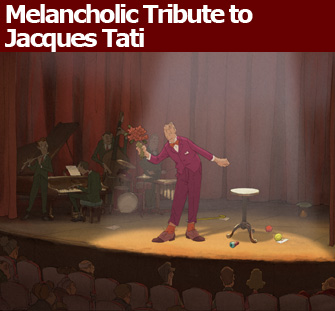
It’s a dream-team concept: Sylvain Chomet, the creator of the marvelous animated film Les Triplettes de Belleville, has made a new animated movie based on an unfinished script by the late, great French director and actor Jacques Tati, L’Illusioniste (The Illusionist).
The two directors share a certain style of wry, gentle humor; a strong visual and color sense; an enormous dose of winsome charm; and a lack of dependence on the spoken word; characters occasionally say something clearly, like “bonjour” or “merci,” but mostly, when they do speak – a rare occurrence – they make gibberish sounds that are somehow comprehensible and make you realize that much of what we say is unnecessary.
The hero of The Illusionist is drawn as a portrait of Mr. Hulot, the character Tati played in his own films: tall, gawky, gangling, slightly stooped, with high-water trousers, a bow tie and red socks – a comic figure filled with pathos in the tradition of Charlie Chaplin. There is always a touch of melancholy in Tati’s films in spite of their quirky humor.
The story, set in 1959 (when the script was written) is a simple one. The illusionist is having a hard time making a living in the world of the music hall as rock and roll and other new types of entertainment grow in popularity. In search of work, he travels from Paris to London and then

Scotland, where he meets a young maid in a country pub who, fascinated by his magical powers, follows him, unbidden, to Edinburgh. There they set up house, chastely, in a hotel inhabited by other down-and-out music-hall entertainers. The illusionist spends what little money he can eke out by working at humiliating jobs to buy pretty things for the girl. Things go from bad to worse… I’ll stop there.
The film’s animation is stunningly beautiful and wonderfully artful, with sumptuous colors and beautiful lighting of each scene. It is the strong point of the film and the most compelling reason to see it.
As a whole, however, I found it slightly boring in the way Tati’s movies sometimes were. Chomet has perfectly captured Tati’s melancholic side – a feeling of tristesse dominates the whole affair – but has somehow lost the humor. There are moments that are obviously meant to be funny, but they didn’t make me laugh, and I didn’t hear

any chuckling from the rest of the audience either. The manic energy that made Les Triplettes de Belleville so much fun is also missing.
The film includes a scene in which the characters go to the cinema to see one of Tati’s best films, Mon Oncle, which only made me regret even more that this dream-team effort wasn’t quite what I had hoped it would be.
Favorite